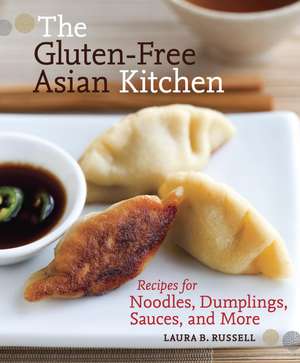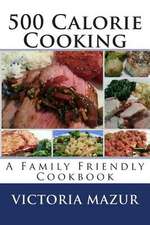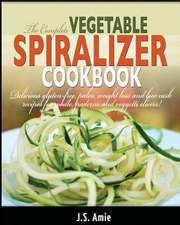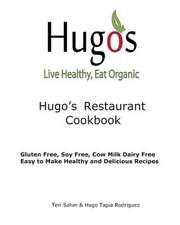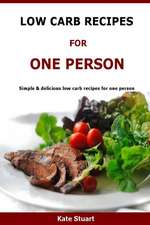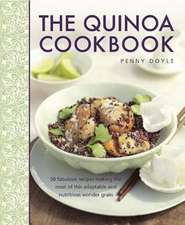The Gluten-Free Asian Kitchen: Recipes for Noodles, Dumplings, Sauces, and More
Autor Laura Byrne Russellen Limba Engleză Paperback – 31 aug 2011
Authentically flavored dishes such as Crispy Spring Rolls, Gingery Pork Pot Stickers, Korean Green Onion Pancakes, Soba Noodles with Stir-Fried Shiitake Mushrooms, Salt and Pepper Squid, and Pork Tonkatsu will be delicious additions to any gluten-free repertoire.
Along with sharing approachable and delicious recipes, Russell demystifies Asian ingredients and helps readers navigate the grocery store. Beautifully photographed and designed for easy weeknight eating, this unique cookbook’s wide range of dishes from a variety of Asian cuisines will appeal to the discriminating tastes of today’s gluten-free cooks.
Preț: 142.02 lei
Nou
Puncte Express: 213
Preț estimativ în valută:
27.18€ • 29.54$ • 22.85£
27.18€ • 29.54$ • 22.85£
Carte disponibilă
Livrare economică 31 martie-14 aprilie
Preluare comenzi: 021 569.72.76
Specificații
ISBN-13: 9781587611353
ISBN-10: 158761135X
Pagini: 201
Ilustrații: 30 FULL-COLOR PHOTOS
Dimensiuni: 192 x 228 x 19 mm
Greutate: 0.62 kg
Editura: CELESTIAL ARTS
ISBN-10: 158761135X
Pagini: 201
Ilustrații: 30 FULL-COLOR PHOTOS
Dimensiuni: 192 x 228 x 19 mm
Greutate: 0.62 kg
Editura: CELESTIAL ARTS
Notă biografică
Laura B. Russell is the former associate editor of Food & Wine cookbooks, the “Gluten Freedom” columnist for the Oregonian, and a frequent contributor to Prevention magazine. She has followed a gluten-free diet since 2007. Visit www.laurabrussell.com.
Extras
Introduction
A few years ago, I sat with my husband and two children in a local Chinese restaurant trying desperately to find something on the menu I could eat that was gluten free. Two women sat down at the table next to us and one of them proceeded to tell her dining companion that she was under strict doctor’s orders to avoid gluten. A kindred spirit, I thought, until she laughed it off and stated authoritatively, “It’s no big deal; I just can’t order the noodles.” My husband reacted calmly as I tried to jump out of my seat—and into their conversation—putting his hand on my arm to keep me in place while quietly shaking his head “no.” “It’s not your concern,” he said.
Oh yes, it is.
My own experience with gluten intolerance started shortly after the birth of my second child. I started fighting off a bevy of bizarre neurological symptoms, beginning with localized nerve pain and eventually growing into facial numbness and paralysis of the left side of my face. At its worst, the numbness traveled down the entire left side of my body. Some of these symptoms remained firmly in place for a couple of years, while others retreated as quickly as they appeared; all were puzzling and scary. About four years into this, and not a single step closer to finding an answer, I turned my focus from fruitlessly searching for a diagnosis to improving my general health. I started a one-month elimination diet, cutting out most foods that were allergenic or inflammatory, including gluten, dairy, soy, corn, caffeine, alcohol, and sugar. Three weeks later, I felt better than I had in years and was completely symptom free. At the end of the month, I took that first bite of a much-missed bagel and—whoosh!—nearly instant facial numbness.
I had discovered my body’s aversion to gluten.
At that point I stopped eating gluten completely, which includes anything containing wheat, barley, rye, or cross-contaminated oats. I don’t have a problem with this when I’m eating at home, but the story changes once I walk out the front door. Dining in any restaurant can be difficult, but going out for Asian food remains my biggest frustration. As I soon discovered, many of the essential ingredients in Asian cooking are wheat-based. Dumplings, pancakes, and many types of noodles are blatant offenders, but it’s the omnipresent sauces, quietly painting each bite with gluten, that are harder to avoid. Soy sauce, a condiment made from fermented soybeans and wheat, is an exceedingly common ingredient in Asian cooking. Other sauces, such as teriyaki sauce and some peanut sauces, are based on soy sauce. Hoisin sauce and oyster sauce are routinely thickened with wheat flour; hoisin sauce may also be sweetened with a wheat paste. In trying to dodge these roadblocks, it can be hard finding even a simple stir-fry that’s safe to eat. Certainly over the past few years the whole concept of gluten-free dining has progressed at a rapid speed, but with much of the commercial focus on getting that bread, that pizza, or that cake back on the plate. But what about other foods that we all love, such as Japanese, Korean, and Chinese, which are some of my personal favorites? I decided that it’s time to shine the spotlight on Asian cooking.
During my gluten-eating days, I frequented Asian restaurants in New York City, Portland, and San Francisco with great vigor. (Not to mention a revelatory food-focused visit to Tokyo with my husband.) As a recipe developer I gobbled up not only the delicacies set before me, but information as well. I studied menus, quizzed helpful chefs, and scoured markets in Chinatown, picking up a bit more knowledge each step of the way. Eventually I started cooking my way through Asian cookbooks at home, a fun and satisfying experience. By the time I had to give up gluten, I realized my newfound skills were critical to my continued enjoyment of Asian food. Any initial sadness I felt over losing gluten was trumped by my delight in knowing how to cook. I somehow felt like sharing this knowledge with other people in the same situation would make the whole ordeal worthwhile.
Gluten free or not, I want everything I eat to be delicious. And while dining out remains one of my favorite pastimes, if I can’t find what I’m craving in a restaurant—more and more common since I went gluten free—then I cook it at home.
The one hundred recipes in this book originate from the Thai, Korean, Chinese, Japanese, and Vietnamese cuisines I love so much. My goal is not to reinvent the wheel or hand you a bunch of strange Asian-fusion concoctions, but to provide solid recipes for some of the great Asian foods you may find yourself missing since you’ve gone gluten free. In this book, I’ve tried to make old favorites accessible again, and I hope to introduce a few new ideas into the mix as well.
In creating this gluten-free Asian lineup, I found the recipes fell into three categories:
Major overhaul: Recipes that needed some type of big conversion to make them gluten free. This includes rethinking panko breadcrumb coatings, wheat-based thickeners, dumpling dough, batters, and traditional sauces.
Tweaking/minor substitution: Recipes that required a simple substitution to create a gluten-free version, such as using wheat-free tamari or gluten-free oyster sauce.
Naturally gluten free: Some recipes are gluten free by nature, specifically many fish sauce–based Thai and Vietnamese recipes. Generally, when I give you a naturally gluten-free recipe, I am hoping to introduce an ingredient or a technique that might be new to you. For instance, Korean rice cakes are gluten free, but maybe you’re not familiar with them. Vietnamese salad rolls don’t contain gluten, but you may appreciate instruction on using the rice paper needed to make them. Or, if you’ve already mastered salad rolls, perhaps you’ll enjoy some of the other interesting ways you can use rice paper—as a crisp wrap for sautéed salmon, for example.
The resulting recipes are approachable and range from simple weeknight stir-fries to more time-consuming dumplings, perfect for the weekend. When you become more familiar with the gluten-free ingredients, you will eventually feel confident enough in your knowledge to take it outside the book, making appropriate gluten-free substitutions in any recipe you come across.
Because this is a gluten-free cookbook (and due to the nature of the topic, it’s dairy free as well), I didn’t want you to have concerns about lack of flavor, odd textures, or any feeling of missing out that people with food sensitivities are already so familiar with. So as part of the process of writing this book, I gathered about twenty friends, all avid gluten eaters, and asked them to taste the recipes as I developed them. The group offered great feedback and even tested the completed recipes in their own kitchens. The home testing garnered overwhelmingly positive results from adults and children alike. And except for the cooks, none was the wiser to the dishes’ gluten-free status.
Thankfully, some large national chain restaurants are starting to offer gluten-free options on their Asian menus. But until more of the smaller, local Asian restaurants familiarize themselves with the fundamentals of gluten-free cooking and they are willing to source and pay for alternate ingredients, we’re largely on our own. (And let’s face it, the thought of strolling into a traditional Chinatown restaurant and asking for a gluten-free menu is fairly unrealistic: Can you please change your centuries-old recipes for me?)
Cooking a delicious Asian meal at home is well within your reach, and I will show you how. I’m handing you the spatula—now it’s your turn to fire up the wok.
ONE Getting Started
Identifying Sources of Gluten in Common Asian Ingredients • 6
Stocking the Gluten-Free Asian Kitchen: A Guide to Ingredients • 10
The Short List • 20
Tools and Techniques • 20
When you go to the grocery store, do you even need a list? Or like most people, do you grab the same set of basics week after week? For many home cooks pressed for time, shopping has become a routine. The idea of shopping for unfamiliar ingredients, particularly those of a foreign cuisine, simply knocks many people out of their comfort zone. Add gluten-free restrictions to the mix and the prospect becomes downright daunting. What’s a home cook to do? Relax, take a deep breath, and work with me.
When the task at hand seems intimidating, I find it best to break things down. In this chapter I’ve included a chart that will help you determine which Asian ingredients contain gluten and why and a guide to ingredients that not only defines what you need, but also points you in the best direction for locating it. While a few of the items require a trip to an Asian market, I tried very hard to use ingredients from well-stocked grocery stores and natural foods markets or co-ops. If you do have an Asian market in your town, though, take a field trip and explore what the market offers; it can be quite transporting. Asian markets offer a wealth of ingredients, often including an amazing produce section and a well-stocked seafood counter. Because the markets house so many unfamiliar ingredients, it may take a scouting trip or two to gain familiarity. Stroll through the aisles, read labels, learn something new.
For gluten-free brands of traditional gluten-laden sauces (soy sauce, oyster, hoisin), I feel more comfortable buying these from a regular grocery store or natural food market because the labels are in English. Label translation can end up with inaccuracies, a chance I’m not willing to take when my health is at stake. If your grocery store doesn’t carry gluten-free brands of the most basic Asian sauces, request the products you need.
I grocery shop for sport, a practice my friends suggest is the exception to the rule. If you don’t share my enthusiasm for shopping, keep your pantry stocked with some of the basics. Check out The Short List in this chapter for the most frequently used items in the book. Purchasing them all at once would be pricey, but consider building your collection to include these staples. Once in place, you can tackle a great many of the recipes after one quick stop for produce, tofu, meat, or fish.
Once you’ve navigated your way through the ingredients, you’ll need to assess your equipment. Some people shy away from Asian cooking, thinking they need to purchase all kinds of specialty gear. Don’t be surprised if I encourage you to buy a wok, but it’s because it’s fun to use, not because owning one is absolutely necessary. In the Tools and Techniques section I list the pots, pans, and tools I relied on when developing the recipes. You’ll be pleasantly surprised to find most of them already in your kitchen—now go in there and get them dirty!
Identifying Sources of Gluten in Common Asian Ingredients
Avoiding gluten in Asian cooking is achieved only with great care and attention to detail. Some of the most common ingredients you will find in Asian recipes or restaurant dishes are listed below, followed by the reason each one may be off limits. Because gluten is found in all forms of wheat, barley, rye, and cross-contaminated oats, those are the ingredients to avoid. The biggest culprit is wheat, although barley and barley malt do make their way into some of these ingredients. I did not notice any rye, but you should still keep an eye out for it. Once armed with this information, you can feel comfortable making substitutions for the prohibited offenders in any recipe you come across. Solutions range from swapping the item for a homemade version, locating a gluten-free brand, or trying a similar alternative.
The gluten-free market is constantly growing and changing. Check your local grocery store for the products you need and request the ones that are missing. Your voice will get these products on the shelves. Very few of the items listed lack a gluten-free alternative, and hopefully in time it will be easy to locate everything we need. In the meantime, new brands appear frequently, but existing brands can change their ingredients. Remain diligent when it comes to label reading and contact companies directly if their labels need clarification.
As you know, gluten can appear in the most unexpected places. Many of the items below should be gluten free (cornstarch, fish sauce, rice vinegar) and nine times out of ten they will be. But it only takes that one surprise ingredient to throw you off course. Read every label, every time.
Stocking the Gluten-Free Asian Kitchen: A Guide to Ingredients
Shopping for ingredients has never been easier, thanks to a proliferation of gluten-free brands. I enlisted friends all over the country to help me search for the items used in the book. They scoured their neighborhood markets, big chain groceries, co-ops, and international markets and told me what they found—and what they didn’t. The key below lists three different places to find ingredients. I use the key with each entry, indicating availability for that item. Regional differences may apply, but if your local stores lack the products you need, ask for them. Grocery stores are very receptive to customer requests. If all else fails, almost everything is available online (see Mail Order Sources, page 192).
Grocery stores (G): This is your everyday grocery store. Many of the (non-refrigerated) ingredients can be found in an “Asian” or “international” aisle. Some grocery stores have a separate section dedicated to natural food and organics and this is where you may find gluten-free versions of more common ingredients, such as soy sauce, as well as many of the specialty flours.
Natural foods markets and upscale grocers (N): This category includes large, upscale markets such as Whole Foods and smaller, independent co-ops. Many of the co-ops have fewer overall choices, but you’re more likely to find the gluten-free brands.
Asian or international markets (A): While some cities have Asian-specific markets, others have international food markets, covering flavors from around the globe. You can find most of what you need here, though I would be careful about purchasing any ingredient with questionable gluten content if it has a non-English label.
Asterisk (*): These ingredients can often contain gluten—be sure to check the label.
Produce/Refrigerated
These items will likely be found in the produce section or in another refrigerated case.
Bean sprouts (G, N, A): The two most commonly available types of bean sprouts are mung (often labeled “conventional”) and soy bean sprouts. Mung bean sprouts are slender and white; soy bean sprouts are slightly plumper with a yellow bean attached to the end. The recipes in this book were tested with mung bean sprouts, but you can use either variety. Bean sprouts are extremely perishable; buy ones that look fresh and crisp and use them within 2 days.
Chiles, fresh (G, N, A): I call for jalapeño chiles (red or green) exclusively in this book, primarily because of their easy availability. Their heat level can vary tremendously; taste before you add them to a dish and adjust the amount if needed. Sometimes I call for red jalapeños, but mostly for visual purposes; you are welcome to use green chiles instead. If you are familiar with other types of chiles and can procure them in your area, substitute as you see fit.
Citrus fruit (G, N, A): Lemon or lime juice always means freshly squeezed. In some instances, the grated peel (zest) is used as well. If you have a glut of fresh citrus juice, freeze some in ice-cube trays and then store the cubes in resealable freezer bags for later.
Cucumber, English (G, N, A): A long, narrow, plastic-wrapped cucumber, less seedy and bitter and with thinner skin than its garden-variety cousin. The recipe will direct you whether or not to remove the peel and seeds.
Galangal (N): Also called Siamese ginger. Used for flavoring soups and curries, this rhizome tastes like a more pungent and citrusy version of ginger. Substitute with regular ginger in a pinch.
Garlic (G, N, A): Always use fresh garlic. Never buy prechopped garlic—it usually contains additives—but peeled garlic cloves from an Asian market make a great time-saving cheat. Store peeled garlic cloves in a covered container in the refrigerator.
Ginger, fresh (G, N, A): Choose a piece of ginger with smooth, thin skin. It should feel firm and heavy, not at all shriveled. Remove the skin with a paring knife or scrape it off with the tip of a spoon. The recipes specify many different ways to prepare ginger: grated, minced, chopped, or sliced. The cutting method makes a difference: grated ginger produces ginger juice, an important component in certain recipes; sliced ginger adds flavor but is removed before serving. Use the technique indicated in the recipe. Fresh ginger freezes well in a resealable freezer bag for up to 2 months. Break off pieces as needed.
Ginger, pickled* (N, A): Slices of fresh ginger pickled in vinegar and sugar. Some commercial brands contain so many additives it may be worthwhile to make your own batch (see page 35). Not all pickled ginger is sold refrigerated; some may be stocked alongside the Asian condiments.
A few years ago, I sat with my husband and two children in a local Chinese restaurant trying desperately to find something on the menu I could eat that was gluten free. Two women sat down at the table next to us and one of them proceeded to tell her dining companion that she was under strict doctor’s orders to avoid gluten. A kindred spirit, I thought, until she laughed it off and stated authoritatively, “It’s no big deal; I just can’t order the noodles.” My husband reacted calmly as I tried to jump out of my seat—and into their conversation—putting his hand on my arm to keep me in place while quietly shaking his head “no.” “It’s not your concern,” he said.
Oh yes, it is.
My own experience with gluten intolerance started shortly after the birth of my second child. I started fighting off a bevy of bizarre neurological symptoms, beginning with localized nerve pain and eventually growing into facial numbness and paralysis of the left side of my face. At its worst, the numbness traveled down the entire left side of my body. Some of these symptoms remained firmly in place for a couple of years, while others retreated as quickly as they appeared; all were puzzling and scary. About four years into this, and not a single step closer to finding an answer, I turned my focus from fruitlessly searching for a diagnosis to improving my general health. I started a one-month elimination diet, cutting out most foods that were allergenic or inflammatory, including gluten, dairy, soy, corn, caffeine, alcohol, and sugar. Three weeks later, I felt better than I had in years and was completely symptom free. At the end of the month, I took that first bite of a much-missed bagel and—whoosh!—nearly instant facial numbness.
I had discovered my body’s aversion to gluten.
At that point I stopped eating gluten completely, which includes anything containing wheat, barley, rye, or cross-contaminated oats. I don’t have a problem with this when I’m eating at home, but the story changes once I walk out the front door. Dining in any restaurant can be difficult, but going out for Asian food remains my biggest frustration. As I soon discovered, many of the essential ingredients in Asian cooking are wheat-based. Dumplings, pancakes, and many types of noodles are blatant offenders, but it’s the omnipresent sauces, quietly painting each bite with gluten, that are harder to avoid. Soy sauce, a condiment made from fermented soybeans and wheat, is an exceedingly common ingredient in Asian cooking. Other sauces, such as teriyaki sauce and some peanut sauces, are based on soy sauce. Hoisin sauce and oyster sauce are routinely thickened with wheat flour; hoisin sauce may also be sweetened with a wheat paste. In trying to dodge these roadblocks, it can be hard finding even a simple stir-fry that’s safe to eat. Certainly over the past few years the whole concept of gluten-free dining has progressed at a rapid speed, but with much of the commercial focus on getting that bread, that pizza, or that cake back on the plate. But what about other foods that we all love, such as Japanese, Korean, and Chinese, which are some of my personal favorites? I decided that it’s time to shine the spotlight on Asian cooking.
During my gluten-eating days, I frequented Asian restaurants in New York City, Portland, and San Francisco with great vigor. (Not to mention a revelatory food-focused visit to Tokyo with my husband.) As a recipe developer I gobbled up not only the delicacies set before me, but information as well. I studied menus, quizzed helpful chefs, and scoured markets in Chinatown, picking up a bit more knowledge each step of the way. Eventually I started cooking my way through Asian cookbooks at home, a fun and satisfying experience. By the time I had to give up gluten, I realized my newfound skills were critical to my continued enjoyment of Asian food. Any initial sadness I felt over losing gluten was trumped by my delight in knowing how to cook. I somehow felt like sharing this knowledge with other people in the same situation would make the whole ordeal worthwhile.
Gluten free or not, I want everything I eat to be delicious. And while dining out remains one of my favorite pastimes, if I can’t find what I’m craving in a restaurant—more and more common since I went gluten free—then I cook it at home.
The one hundred recipes in this book originate from the Thai, Korean, Chinese, Japanese, and Vietnamese cuisines I love so much. My goal is not to reinvent the wheel or hand you a bunch of strange Asian-fusion concoctions, but to provide solid recipes for some of the great Asian foods you may find yourself missing since you’ve gone gluten free. In this book, I’ve tried to make old favorites accessible again, and I hope to introduce a few new ideas into the mix as well.
In creating this gluten-free Asian lineup, I found the recipes fell into three categories:
Major overhaul: Recipes that needed some type of big conversion to make them gluten free. This includes rethinking panko breadcrumb coatings, wheat-based thickeners, dumpling dough, batters, and traditional sauces.
Tweaking/minor substitution: Recipes that required a simple substitution to create a gluten-free version, such as using wheat-free tamari or gluten-free oyster sauce.
Naturally gluten free: Some recipes are gluten free by nature, specifically many fish sauce–based Thai and Vietnamese recipes. Generally, when I give you a naturally gluten-free recipe, I am hoping to introduce an ingredient or a technique that might be new to you. For instance, Korean rice cakes are gluten free, but maybe you’re not familiar with them. Vietnamese salad rolls don’t contain gluten, but you may appreciate instruction on using the rice paper needed to make them. Or, if you’ve already mastered salad rolls, perhaps you’ll enjoy some of the other interesting ways you can use rice paper—as a crisp wrap for sautéed salmon, for example.
The resulting recipes are approachable and range from simple weeknight stir-fries to more time-consuming dumplings, perfect for the weekend. When you become more familiar with the gluten-free ingredients, you will eventually feel confident enough in your knowledge to take it outside the book, making appropriate gluten-free substitutions in any recipe you come across.
Because this is a gluten-free cookbook (and due to the nature of the topic, it’s dairy free as well), I didn’t want you to have concerns about lack of flavor, odd textures, or any feeling of missing out that people with food sensitivities are already so familiar with. So as part of the process of writing this book, I gathered about twenty friends, all avid gluten eaters, and asked them to taste the recipes as I developed them. The group offered great feedback and even tested the completed recipes in their own kitchens. The home testing garnered overwhelmingly positive results from adults and children alike. And except for the cooks, none was the wiser to the dishes’ gluten-free status.
Thankfully, some large national chain restaurants are starting to offer gluten-free options on their Asian menus. But until more of the smaller, local Asian restaurants familiarize themselves with the fundamentals of gluten-free cooking and they are willing to source and pay for alternate ingredients, we’re largely on our own. (And let’s face it, the thought of strolling into a traditional Chinatown restaurant and asking for a gluten-free menu is fairly unrealistic: Can you please change your centuries-old recipes for me?)
Cooking a delicious Asian meal at home is well within your reach, and I will show you how. I’m handing you the spatula—now it’s your turn to fire up the wok.
ONE Getting Started
Identifying Sources of Gluten in Common Asian Ingredients • 6
Stocking the Gluten-Free Asian Kitchen: A Guide to Ingredients • 10
The Short List • 20
Tools and Techniques • 20
When you go to the grocery store, do you even need a list? Or like most people, do you grab the same set of basics week after week? For many home cooks pressed for time, shopping has become a routine. The idea of shopping for unfamiliar ingredients, particularly those of a foreign cuisine, simply knocks many people out of their comfort zone. Add gluten-free restrictions to the mix and the prospect becomes downright daunting. What’s a home cook to do? Relax, take a deep breath, and work with me.
When the task at hand seems intimidating, I find it best to break things down. In this chapter I’ve included a chart that will help you determine which Asian ingredients contain gluten and why and a guide to ingredients that not only defines what you need, but also points you in the best direction for locating it. While a few of the items require a trip to an Asian market, I tried very hard to use ingredients from well-stocked grocery stores and natural foods markets or co-ops. If you do have an Asian market in your town, though, take a field trip and explore what the market offers; it can be quite transporting. Asian markets offer a wealth of ingredients, often including an amazing produce section and a well-stocked seafood counter. Because the markets house so many unfamiliar ingredients, it may take a scouting trip or two to gain familiarity. Stroll through the aisles, read labels, learn something new.
For gluten-free brands of traditional gluten-laden sauces (soy sauce, oyster, hoisin), I feel more comfortable buying these from a regular grocery store or natural food market because the labels are in English. Label translation can end up with inaccuracies, a chance I’m not willing to take when my health is at stake. If your grocery store doesn’t carry gluten-free brands of the most basic Asian sauces, request the products you need.
I grocery shop for sport, a practice my friends suggest is the exception to the rule. If you don’t share my enthusiasm for shopping, keep your pantry stocked with some of the basics. Check out The Short List in this chapter for the most frequently used items in the book. Purchasing them all at once would be pricey, but consider building your collection to include these staples. Once in place, you can tackle a great many of the recipes after one quick stop for produce, tofu, meat, or fish.
Once you’ve navigated your way through the ingredients, you’ll need to assess your equipment. Some people shy away from Asian cooking, thinking they need to purchase all kinds of specialty gear. Don’t be surprised if I encourage you to buy a wok, but it’s because it’s fun to use, not because owning one is absolutely necessary. In the Tools and Techniques section I list the pots, pans, and tools I relied on when developing the recipes. You’ll be pleasantly surprised to find most of them already in your kitchen—now go in there and get them dirty!
Identifying Sources of Gluten in Common Asian Ingredients
Avoiding gluten in Asian cooking is achieved only with great care and attention to detail. Some of the most common ingredients you will find in Asian recipes or restaurant dishes are listed below, followed by the reason each one may be off limits. Because gluten is found in all forms of wheat, barley, rye, and cross-contaminated oats, those are the ingredients to avoid. The biggest culprit is wheat, although barley and barley malt do make their way into some of these ingredients. I did not notice any rye, but you should still keep an eye out for it. Once armed with this information, you can feel comfortable making substitutions for the prohibited offenders in any recipe you come across. Solutions range from swapping the item for a homemade version, locating a gluten-free brand, or trying a similar alternative.
The gluten-free market is constantly growing and changing. Check your local grocery store for the products you need and request the ones that are missing. Your voice will get these products on the shelves. Very few of the items listed lack a gluten-free alternative, and hopefully in time it will be easy to locate everything we need. In the meantime, new brands appear frequently, but existing brands can change their ingredients. Remain diligent when it comes to label reading and contact companies directly if their labels need clarification.
As you know, gluten can appear in the most unexpected places. Many of the items below should be gluten free (cornstarch, fish sauce, rice vinegar) and nine times out of ten they will be. But it only takes that one surprise ingredient to throw you off course. Read every label, every time.
Stocking the Gluten-Free Asian Kitchen: A Guide to Ingredients
Shopping for ingredients has never been easier, thanks to a proliferation of gluten-free brands. I enlisted friends all over the country to help me search for the items used in the book. They scoured their neighborhood markets, big chain groceries, co-ops, and international markets and told me what they found—and what they didn’t. The key below lists three different places to find ingredients. I use the key with each entry, indicating availability for that item. Regional differences may apply, but if your local stores lack the products you need, ask for them. Grocery stores are very receptive to customer requests. If all else fails, almost everything is available online (see Mail Order Sources, page 192).
Grocery stores (G): This is your everyday grocery store. Many of the (non-refrigerated) ingredients can be found in an “Asian” or “international” aisle. Some grocery stores have a separate section dedicated to natural food and organics and this is where you may find gluten-free versions of more common ingredients, such as soy sauce, as well as many of the specialty flours.
Natural foods markets and upscale grocers (N): This category includes large, upscale markets such as Whole Foods and smaller, independent co-ops. Many of the co-ops have fewer overall choices, but you’re more likely to find the gluten-free brands.
Asian or international markets (A): While some cities have Asian-specific markets, others have international food markets, covering flavors from around the globe. You can find most of what you need here, though I would be careful about purchasing any ingredient with questionable gluten content if it has a non-English label.
Asterisk (*): These ingredients can often contain gluten—be sure to check the label.
Produce/Refrigerated
These items will likely be found in the produce section or in another refrigerated case.
Bean sprouts (G, N, A): The two most commonly available types of bean sprouts are mung (often labeled “conventional”) and soy bean sprouts. Mung bean sprouts are slender and white; soy bean sprouts are slightly plumper with a yellow bean attached to the end. The recipes in this book were tested with mung bean sprouts, but you can use either variety. Bean sprouts are extremely perishable; buy ones that look fresh and crisp and use them within 2 days.
Chiles, fresh (G, N, A): I call for jalapeño chiles (red or green) exclusively in this book, primarily because of their easy availability. Their heat level can vary tremendously; taste before you add them to a dish and adjust the amount if needed. Sometimes I call for red jalapeños, but mostly for visual purposes; you are welcome to use green chiles instead. If you are familiar with other types of chiles and can procure them in your area, substitute as you see fit.
Citrus fruit (G, N, A): Lemon or lime juice always means freshly squeezed. In some instances, the grated peel (zest) is used as well. If you have a glut of fresh citrus juice, freeze some in ice-cube trays and then store the cubes in resealable freezer bags for later.
Cucumber, English (G, N, A): A long, narrow, plastic-wrapped cucumber, less seedy and bitter and with thinner skin than its garden-variety cousin. The recipe will direct you whether or not to remove the peel and seeds.
Galangal (N): Also called Siamese ginger. Used for flavoring soups and curries, this rhizome tastes like a more pungent and citrusy version of ginger. Substitute with regular ginger in a pinch.
Garlic (G, N, A): Always use fresh garlic. Never buy prechopped garlic—it usually contains additives—but peeled garlic cloves from an Asian market make a great time-saving cheat. Store peeled garlic cloves in a covered container in the refrigerator.
Ginger, fresh (G, N, A): Choose a piece of ginger with smooth, thin skin. It should feel firm and heavy, not at all shriveled. Remove the skin with a paring knife or scrape it off with the tip of a spoon. The recipes specify many different ways to prepare ginger: grated, minced, chopped, or sliced. The cutting method makes a difference: grated ginger produces ginger juice, an important component in certain recipes; sliced ginger adds flavor but is removed before serving. Use the technique indicated in the recipe. Fresh ginger freezes well in a resealable freezer bag for up to 2 months. Break off pieces as needed.
Ginger, pickled* (N, A): Slices of fresh ginger pickled in vinegar and sugar. Some commercial brands contain so many additives it may be worthwhile to make your own batch (see page 35). Not all pickled ginger is sold refrigerated; some may be stocked alongside the Asian condiments.
Recenzii
“This book proves that Asian food can accommodate a gluten-free diet, and it is an excellent introduction to Asian cooking even for those who don’t have gluten allergies.”
—Library Journal, 6/15/11
“With this book, Laura Russell helps more people enjoy Asian cooking. Her work is chock full of tantalizing recipes and practical information.”
—Andrea Nguyen, author of Into the Vietnamese Kitchen and Asian Dumplings
“The Gluten-Free Asian Kitchen is a marvelous cookbook that brings wonderful diversity to our gluten-free lifestyle. Informatively written and beautifully photographed, it is your invitation to mouthwatering Asian cuisine that will tantalize your taste buds and have your family and guests clamoring for more.”
—Carol Fenster, award-winning author of 100 Best Gluten-Free Recipes
“Laura Russell’s debut cookbook delivers mouthwatering recipes with reassuring headnotes. This is an amazing book and one that is much needed for those of us who crave Asian foods but need to eat a gluten-free diet.”
—Diane Morgan, author of The New Thanksgiving Table and Gifts Cooks Love
“I’m so excited to see The Gluten-Free Asian Kitchen in the world. Laura Russell clearly cares deeply about feeding us great food—like Sweet Potato Noodles with Beef and Vegetables, Steamed Sea Bass with Sizzling Ginger, and Korean Green Onion Pancakes—without any fear of us growing sick. Finally I can learn how to make dumplings, gluten-free!”
—Shauna James Ahern, author of Gluten-Free Girl and the Chef
—Library Journal, 6/15/11
“With this book, Laura Russell helps more people enjoy Asian cooking. Her work is chock full of tantalizing recipes and practical information.”
—Andrea Nguyen, author of Into the Vietnamese Kitchen and Asian Dumplings
“The Gluten-Free Asian Kitchen is a marvelous cookbook that brings wonderful diversity to our gluten-free lifestyle. Informatively written and beautifully photographed, it is your invitation to mouthwatering Asian cuisine that will tantalize your taste buds and have your family and guests clamoring for more.”
—Carol Fenster, award-winning author of 100 Best Gluten-Free Recipes
“Laura Russell’s debut cookbook delivers mouthwatering recipes with reassuring headnotes. This is an amazing book and one that is much needed for those of us who crave Asian foods but need to eat a gluten-free diet.”
—Diane Morgan, author of The New Thanksgiving Table and Gifts Cooks Love
“I’m so excited to see The Gluten-Free Asian Kitchen in the world. Laura Russell clearly cares deeply about feeding us great food—like Sweet Potato Noodles with Beef and Vegetables, Steamed Sea Bass with Sizzling Ginger, and Korean Green Onion Pancakes—without any fear of us growing sick. Finally I can learn how to make dumplings, gluten-free!”
—Shauna James Ahern, author of Gluten-Free Girl and the Chef
Cuprins
Introduction • 1
One Getting Started • 4
Identifying Sources of Gluten in Common Asian Ingredients • 6
Stocking the Gluten-Free Asian Kitchen: A Guide to Ingredients • 10
The Short List • 20
Tools and Techniques • 20
Two Sauces and Stocks • 24
Three Skewers and Snacks • 38
Four Dumplings and Savory Pancakes • 54
Five Noodles • 78
Six Rice • 96
Seven Vegetables and Tofu • 112
Eight Seafood • 130
Nine Poultry • 144
Ten Meat • 160
Eleven Sips and Sweets • 174
Mail Order Sources • 192
Acknowledgments • 193
Bibliography • 195
Index • 196
One Getting Started • 4
Identifying Sources of Gluten in Common Asian Ingredients • 6
Stocking the Gluten-Free Asian Kitchen: A Guide to Ingredients • 10
The Short List • 20
Tools and Techniques • 20
Two Sauces and Stocks • 24
Three Skewers and Snacks • 38
Four Dumplings and Savory Pancakes • 54
Five Noodles • 78
Six Rice • 96
Seven Vegetables and Tofu • 112
Eight Seafood • 130
Nine Poultry • 144
Ten Meat • 160
Eleven Sips and Sweets • 174
Mail Order Sources • 192
Acknowledgments • 193
Bibliography • 195
Index • 196
Descriere
Asian food poses unique challenges to the gluten-free cook because of its heavy reliance on kitchen staples such as noodles, soy sauce, and oyster sauce that typically contain wheat. But with culinary know-how and ingredient awareness, any home cook can quickly and simply turn out these 100 gluten-free, full-flavored dishes.
